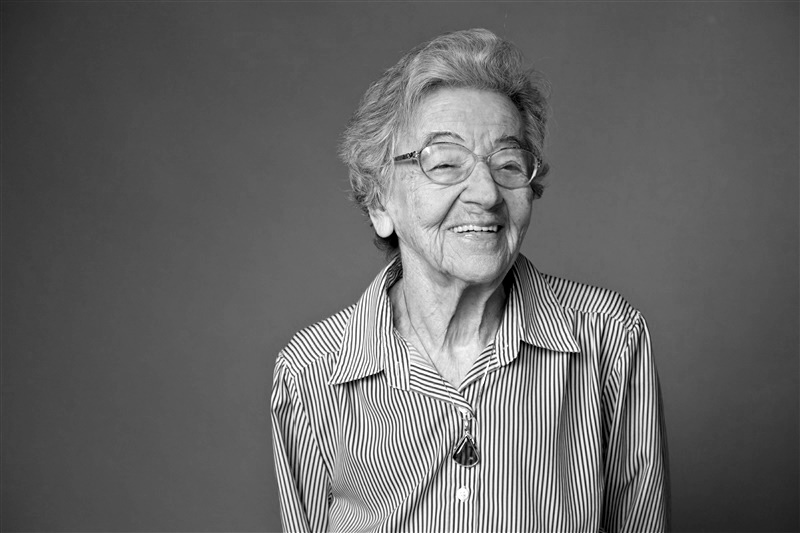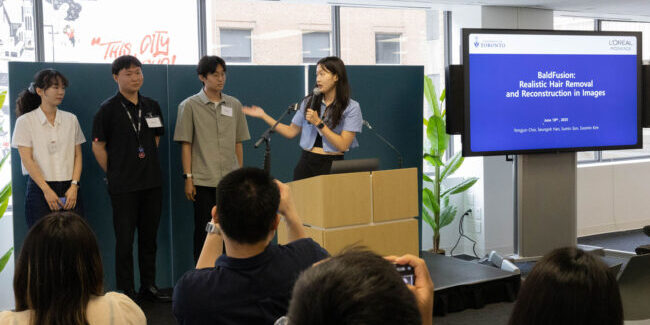Ursula Franklin is one of several inspirational women in the Canadian materials, metallurgy and mining field being celebrated at a Women of Impact symposium on Wednesday, August 26. Hosted in Toronto by the Canadian Institute of Mining, Metallurgy and Petroleum, the event includes panels, presentations and working groups, and it is free for students. Register today.
University Professor Emerita Ursula Franklin is a world-renowned materials scientist, educator and activist. Franklin joined U of T Engineering in 1967 as the first female professor of metallurgy and materials science (now known as materials science and engineering). In 1984, she became the first woman to receive the title of University Professor, the highest academic rank at U of T. As a pioneer in her field and a prolific writer on the social impact of technology, Franklin has inspired countless young women and men both within and outside science and engineering fields. (Read her full bio below)
How did your family background influence your interest in science?
I had very good, very serious parents. My father had four sisters, all of whom led their own life in the terms of that time. My mother was an academic. There was no question I could do whatever I felt I was able to do and interested in. There were no barriers. There was a very strong emphasis on thoughts, ideas, intellectual life rather than material things. My family was political. I had a very appropriate upbringing to end up in science, but I could have done anything else as far as my family was concerned. I went into science largely because of other things that were foreclosed to me.
My mother was Jewish and so another thing for me, being born in 1921, was that I was a young child when the Nazis came to power and with them the Nuremburg Laws and all it entailed. So, going into politics, going into law, was out of the question. What attracted me to science at that time was that it appeared to be objective. I remember being at school and seeing physics experiments and seeing a cathode ray tube and the magnet and the beam being bent and I suddenly had this feeling of great joy that even they, those people in government who were after us, couldn’t make an electron beam bend in any other direction. So, science seemed to be the field where I could escape politics.
Where do you feel you have made the biggest impact in your field?
The question of my own impact is hard to answer. I think that my most important contribution was, in fact, being there: my ongoing presence, the fact that young women knew where to find me, that I was ready to be consulted, and that my own career evolved clearly and openly. I do not think that any single thing that I did was unique, but the trajectory of a consistent professional life gave a sense of reality and possibility to others.
What did it mean to you to be appointed the first woman University Professor at the University of Toronto?
I was very pleased about it. There is such a profound difference in being the first and being the only. If you are the only woman, people can treat you like an oddity; if you are the first, then it is quite different. When you enter as the first, you begin not to feel so much personal discrimination, that cold blast of air that comes, “Oh dear, there they come and they may know something and they may want a job and they may want to change things.” There’s a profound difference. So being the first woman University Professor, I was really happy because it meant there would be others.
The one great joy I felt in my academic life, seeing the promotion of women, is that they got younger and younger. These incredibly long waiting times before competent women could be promoted would become progressively shorter. To see young women who have a life ahead of them be in a position that they deserve, that they have the scope and the recognition and the responsibility that they could carry, that, is real achievement. The next ones can be younger, more joyful, have more productive lives ahead of them, after they have been given recognition and some elbowroom.
Have you felt a responsibility to be a role model and mentor?
I did very much feel a responsibility with regard to mentoring, to see that the younger women wouldn’t get hurt or bruised. Many of my friendships with other women came out of that wish to see that the young women don’t drop out. I have now a number of good friends who were senior women in various positions; we met and worked with each other almost entirely by trying to find jobs, accreditation, and opportunities for women students or women engineers who came with offshore qualifications or women who ended up in community colleges because they couldn’t get other jobs. We tried to keep an eye and be in some way an extra protective coat for the younger women who had to go through the difficulties of an engineering education or the workplace.
How can we best nurture female leaders?
By hitting the guys on the rump every once in a while. There’s nothing wrong with women. In one of my papers that I wrote for Monique Frize after her remarkable efforts on women in engineering, I said how leery I am of attempts to make women fit into the male world. I call that weightlifting for girls. I don’t want to adjust women to the rough, tumble rudeness that used to be the world of engineers. I want to change the world of engineers so that women, while being practicing engineers, can also safely and cheerfully be themselves.
I’m one for setting some standards in the workplace so that it makes it unnecessary for women to look for protection. Again, it’s not a private opinion, it’s a structure: the structure of the workplace that contains men, women, and minorities has to be safe. The safest have to look after the least safe. There’s no other way of doing things.
What can we do now to promote women in science and engineering?
If you want to make this a civilized environment for women, it has to be a civilized environment for all. Women will and may change from being the obvious minority. It may be somebody else who’s next, who will be discriminated against. It must be a civilized workplace in which all who are competent and qualified can work without fear and without embarrassment. I think there’s a lot that needs to be done but it’s at the side of the powerful, not the powerless. It’s the powerful’s obligation to be civilized.
I can only say the same thing again and again: there’s nothing wrong with women and there’s nothing wrong with feminism — to say that it is essential to build one’s relationships on collaboration and not on rejection. It’s unpopular but it’s the only thing that works. I have no magic formula for how to convince the powerful to see that except it’s them who get hurt, and it’s them whose lives are deprived because they believe that hurting is legitimate. What’s left for them? They’re feared.
About Ursula Franklin:
Ursula was born on September 16, 1921, in Munich, Germany. She was the only child in an academic German family. Her mother was Jewish and an art historian; her father came from an old German Lutheran family and he was an ethnographer. The biggest influences in her life, Ursula says, were her parents and the natural world. A close family friend of her parents was a physicist and she attributes much of her interest in math and science to his influence. Ursula graduated from an all-girls high school in 1939 and in the spring of 1940 began her undergraduate education in Berlin. Early on, she says, she became “fascinated by the very nature of structure and the relationship between structure and properties in materials.” Her great interest was crystallography. For the last eighteen months of the Second World War, Ursula was imprisoned in a Nazi work camp. Immediately after the collapse of Nazi Germany, she enrolled at the Technical University of Berlin to finish her studies, joining the department headed by Professor Hartmut Kallmann in December 1946.
Ursula obtained her doctorate in experimental physics in 1948. In 1949 she received the Lady Davis Fellowship and came to Canada as a post-doctoral fellow at the University of Toronto. She had hoped to be part of the effort to rebuild Germany, but after the Berlin blockade (one of the first major crises of the Cold War), she realized it would be impossible to build the sort of society she envisioned. The wives of the faculty at the University of Toronto were extraordinarily supportive and helped Ursula settle and improve her English. At the end of her post-doc, she took the first job offered to her and joined the Ontario Research Foundation as a senior scientist. She stayed there for fifteen years, working with practising engineers to solve problems in industry. During this time, she married Fred Franklin. Their children, Martin (born 1955) and Monica (born 1958) grew up with their parents working and being involved in public life.
In the early 1960s, Ursula’s research on strontium-90 in Canadian children’s baby teeth was instrumental in persuading all Cold War governments to cease atmospheric nuclear weapons testing. In 1967 Ursula was recruited to join what was then the Department of Metallurgy and Materials Science in the Faculty of Applied Science and Engineering at the University of Toronto — she was the first female professor in the department. The department was trying to push into the materials field and Ursula had developed her expertise in radiography and crystallography. There, she pioneered the field of archaeometry, applying modern materials science to the study and dating of archaeological materials, such as bronze, metals, and ceramics. Ursula was appointed full professor in 1973 and in 1984 was the first woman named University Professor at the University of Toronto, the institution’s highest honour.
Ursula has been dedicated to improving science policy. From 1974 to 1977 she was a member of the Science Council of Canada and chaired its committee on the implications of a conserver society. From 1978 to 1981 she was a member of NSERC. In 1989 Ursula delivered the Massey Lectures, which were subsequently published as The Real World of Technology. That same year, Franklin retired from the University of Toronto. She continues to work as a senior resident and fellow at Massey College. Most recently, she published two collections of her speeches and writings: The Ursula Franklin Reader: Pacifism as a Map (2006) and Ursula Franklin Speaks: Thoughts and Afterthoughts (2014).
Ursula holds more than forty honorary doctorates and has received numerous awards. In 1982 she was made an officer of the Order of Canada. That same year, she was also the first woman awarded the CIM Distinguished Lecturer Award. In 1993 she was elected to the Royal Society of Canada. In recognition of her humanitarian work, she received the United Nations Association’s Pearson Peace Medal in 2002.
Excerpted from Women of Impact in the Canadian Materials, Metallurgy and Mining Field by Anne Millar and Mary Wells. Reprinted with the permission of the Canadian Institute of Mining, Metallurgy and Petroleum (CIM). Copyright © 2015.




